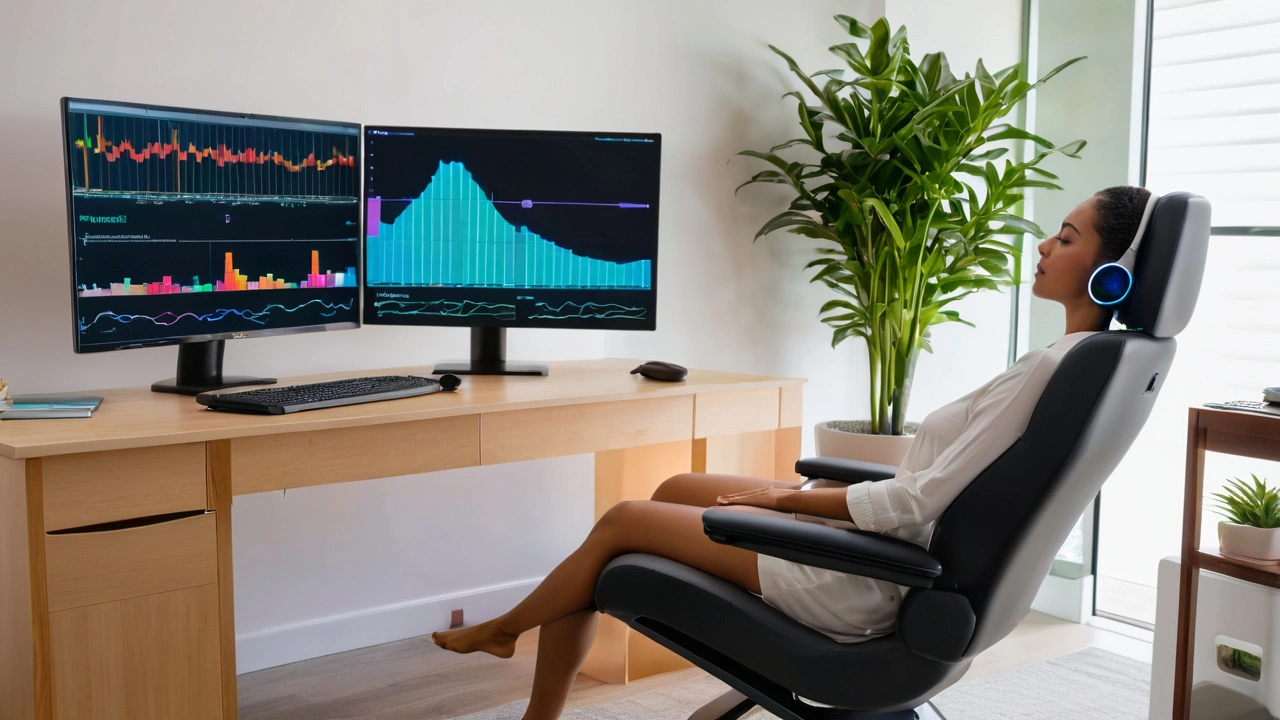
Imagine tapping into your body's innate wisdom, using real-time data to enhance your mind-body connection. Biofeedback is not a far-fetched fantasy but a proven method that allows you to do just that. By understanding what biofeedback is and how it works, you can use this technique to improve various aspects of your life.
This comprehensive guide walks you through the essentials of biofeedback, its potential benefits, and how to practically incorporate it into your daily routine. Whether aiming to reduce stress, improve concentration, or enhance overall wellbeing, biofeedback can be a powerful tool in your personal development arsenal.
- Introduction to Biofeedback
- How Biofeedback Works
- Benefits of Biofeedback
- Practical Tips for Using Biofeedback
- Success Stories and Personal Experiences
Introduction to Biofeedback
Biofeedback is a fascinating field that merges psychology and physiology to create a powerful tool for self-improvement. At its core, biofeedback is all about using real-time information about our body's functions to gain control over them. Imagine being able to see your heart rate or muscle tension on a screen and learning how to adjust your breathing or thoughts to change those readings. It sounds like something out of a science fiction novel, but it’s entirely real and achievable.
The concept of biofeedback dates back to the 1960s when researchers started to explore how individuals could gain control over physiological processes previously thought to be automatic, like heart rate or blood pressure. Today, biofeedback can help people manage various conditions, including stress, chronic pain, and even certain types of headaches. According to the Association for Applied Psychophysiology and Biofeedback (AAPB), biofeedback is a technique you can use to learn to control your body's functions, such as your heart rate.
So, how does biofeedback actually work? It starts with sensors attached to different parts of your body. These sensors measure physiological activities such as brain waves, heart function, breathing, muscle activity, and skin temperature. This data is then fed back to you via a monitor, giving you real-time information about what’s happening inside your body. This feedback loop allows you to experiment with different strategies — such as deep breathing, visualization, or guided imagery — and immediately see the effects on your physiological responses.
Different types of biofeedback target different physiological functions. For example, Electroencephalography (EEG) biofeedback or neurofeedback focuses on brain wave patterns, while electromyography (EMG) biofeedback measures muscle activity. Heart rate variability (HRV) biofeedback is another popular form that helps you learn how to regulate your heart rate through breathing techniques. According to Johns Hopkins Medicine, biofeedback can be an effective way to manage stress-related health issues by teaching people to control their physiological functions.
“Don't simply shrug off the idea of biofeedback as just another wellness trend. The science behind it is both intriguing and robust,” shares Dr. Carolyn Petersen, a biofeedback expert with over 20 years of experience.
What makes biofeedback particularly powerful is its non-invasive nature and the emphasis on self-control. By harnessing biofeedback techniques, you can learn to influence functions that are usually involuntary, giving you greater command over your mental and physical well-being. There’s no need for medication, which means fewer side effects and interactions with other treatments you might be using.
Whether you're a biofeedback newbie or someone looking to deepen their understanding, knowing the foundational principles will set you on the right path. With a growing body of research and ever-evolving technology, biofeedback continues to be a promising tool for those interested in taking an active role in their health and wellness.
How Biofeedback Works
Biofeedback is a fascinating blend of technology and natural body processes. At its core, biofeedback uses electronic sensors to monitor physiological functions such as heart rate, muscle tension, and skin temperature. These sensors are non-invasive and provide real-time data that you can immediately see on a display screen.
The idea behind biofeedback is simple yet profound. By making unconscious bodily processes visible, the technique empowers you to gain control over certain physiological functions. This means you can learn to consciously regulate heart rate, relax muscles, or even manage your stress response more effectively. Research has shown that such self-regulation can significantly improve mental and physical health.
In a typical biofeedback session, you might use devices like a heart rate monitor, electroencephalograph (EEG), or electromyograph (EMG). These tools measure different physiological responses based on your goals. For example, an EEG might be used to monitor brainwaves if you are looking to improve mental focus or manage anxiety.
One of the most compelling aspects of biofeedback is how interactive it is. The real-time feedback loop allows you to experiment with different techniques and see immediate results. For instance, you might notice that practicing deep breathing lowers your heart rate or that visualizing a calm scene reduces muscle tension. Such immediate feedback helps you find what works best for you.
This process isn't just about observation; it is about learning and adapting. Your body gradually learns to respond to different stressors in healthier ways. Over time, the goal is to internalize these changes so you no longer need the equipment to maintain the benefits. This learned self-regulation is a key reason many people find biofeedback so compelling.
Biofeedback isn't a new concept; it has been around for several decades. However, advancements in technology have made it more accessible and user-friendly. Once confined to clinical settings, biofeedback devices are now available for home use, making it easier for people to incorporate this technique into their daily lives. As noted by the Mayo Clinic, biofeedback offers a promising way to manage conditions like high blood pressure and chronic pain.
"Biofeedback has proven to be an invaluable tool in helping patients gain greater control over involuntary body processes, paving the way for improved health and wellness." - Mayo Clinic
While the technology is important, the success of biofeedback also relies on your willingness to engage with the process actively. It's about creating a partnership between you and the technology, where each session brings you closer to a deeper understanding of your body's signals. This collaboration can be incredibly empowering, giving you the tools to take charge of your health and wellbeing.

Benefits of Biofeedback
Biofeedback, a powerful blend of technology and personal insight, brings a myriad of benefits. One of the most acclaimed is its ability to manage stress. By monitoring physiological signals like heart rate, muscle tension, and respiration, individuals learn to recognize and control their stressors. This feedback loop allows them to adopt relaxation techniques when they notice their stress levels rising. Being mindful of these signals can significantly impact daily stress management.
Another notable benefit is enhanced concentration and mental clarity. Many professionals and students use biofeedback to train their brains for better focus. Through consistent practice, it is possible to improve attention span and cognitive function. Studies have shown that biofeedback can help those with ADHD, improving their ability to concentrate on tasks. This makes biofeedback an invaluable tool for not just children but adults too, eager to boost their productivity.
Biofeedback also plays an instrumental role in pain management. Chronic pain sufferers often find relief through these methods. By understanding how their bodies react to pain and learning to control those reactions, they can reduce their discomfort. Techniques such as deep breathing, muscle relaxation, and guided imagery can be employed to manage pain better. The sense of control over one's body is empowering and often reduces the perception of pain.
Sports and physical fitness enthusiasts have leveraged biofeedback for performance enhancement. Athletes use it to monitor physiological parameters and adjust their training regimens accordingly. By keeping track of metrics like heart rate variability and muscle performance, athletes can optimize their workouts and recovery processes. This provides them with a competitive edge, as they can fine-tune their physical and mental states for peak performance.
Improved sleep is another significant benefit. Many people struggle with insomnia or poor sleep quality due to stress or irregular routines. Biofeedback helps by training the body to relax, encouraging better sleep habits. By monitoring patterns and making necessary adjustments, such as using relaxation exercises before bedtime, individuals can improve their sleep quality over time. Better sleep naturally leads to improved mood, cognitive function, and overall health.
According to Dr. Karen Lawson, a clinical biochemist and biofeedback researcher, "Biofeedback empowers individuals by teaching them how to develop awareness and control over physiological functions that are typically considered involuntary."
In summary, biofeedback is a multifaceted tool that offers benefits in various areas such as stress management, mental clarity, pain relief, athletic performance, and sleep enhancement. By integrating biofeedback techniques into your daily routine, you can gain greater insight into your body's responses and improve your overall well-being.
Practical Tips for Using Biofeedback
Using biofeedback effectively requires a blend of patience, regular practice, and determination. One of the first steps in making biofeedback a part of your life is to select the right equipment. There are numerous biofeedback devices available, ranging from portable devices you can use at home to more advanced systems found in professional settings. Starting with a user-friendly home device can help you become familiar with the basic process before investing in more sophisticated technology.
Once you have your equipment, setting a consistent practice schedule is crucial. Dedicating just 15-20 minutes a day to biofeedback practice can lead to significant improvements. Find a quiet, comfortable place where you can fully concentrate without interruptions. Regular practice helps you better understand your body's signals and how to control them. Over time, this awareness and control translate to better stress management, improved focus, and overall enhanced wellbeing.
Understanding what you're looking at when using biofeedback is essential. Most devices provide visual or auditory feedback indicating physiological activity such as heart rate variability, muscle tension, or brainwave patterns. Familiarize yourself with these indicators and learn how to interpret them. For instance, a steady, even heart rate is usually a sign of relaxation, while irregular patterns might indicate stress or agitation.
Incorporating relaxation techniques into your biofeedback practice can boost its effectiveness significantly. Techniques such as deep breathing, guided imagery, and progressive muscle relaxation can be used alongside biofeedback to enhance relaxation and control physiological responses. For example, practicing deep breathing while monitoring heart rate variability can help you see the immediate impact of relaxation on your body.
Patience is key when using biofeedback. It may take time to notice significant changes, and initial sessions can sometimes feel overwhelming. It's important to remind yourself that this is a learning process. Staying positive and persistent will eventually yield results. As you become more familiar with controlling your body's responses, you'll likely find it easier and more intuitive to achieve the desired outcomes.
Working with a professional can also offer valuable guidance. Many users find that biofeedback therapy with a trained professional helps them gain deeper insights and faster results. Professionals can help tailor your practice to your specific needs and provide personalized feedback that can be very beneficial during your biofeedback journey.
Lastly, keep track of your progress. Maintaining a journal where you record your biofeedback sessions, including the techniques used and changes noticed, can be a motivating tool. It allows you to reflect on how far you’ve come and can highlight patterns that can help improve your practice. For example, you might notice that practicing at a certain time of day yields better results or that certain relaxation techniques work better for you.
"The goal of biofeedback is to become more aware of physiological processes and self-regulate them, thereby achieving better mental and physical health," says Dr. Erik Peper, Professor of Holistic Health at San Francisco State University.
By embracing these tips and integrating biofeedback into your routine, you can harness the power of this technique to make meaningful changes in your life. As you develop more control over your physiological responses, you'll likely find yourself feeling more relaxed, focused, and in tune with your body and mind.

Success Stories and Personal Experiences
One of the most inspiring facets of biofeedback is the tangible success it brings into the lives of individuals. Take, for example, Jane Andrews, a high-stress executive who came across biofeedback while searching for alternatives to deal with her chronic anxiety. After a few months of consistent practice, Jane reported a dramatic improvement in her daily stress levels. By learning to control her breathing and heart rate using biofeedback data, Jane managed to reduce her anxiety attacks by 70%, a change that transformed her professional and personal life.
Biofeedback has also shown remarkable success in aiding athletes. Tom Michaels, a professional marathon runner, incorporated biofeedback into his training regimen on the recommendation of his coach. Tom learned to manage his stress response during intense training sessions, ultimately lowering his cortisol levels and improving his performance. This isn't just anecdotal evidence. Research published in the International Journal of Psychophysiology highlights that athletes using biofeedback showed improved performance metrics in endurance sports.
In the realm of education, biofeedback is making waves as well. Sarah Collins, a high school teacher, introduced biofeedback techniques in her classroom to help students manage exam-related stress. The results were outstanding, with students showing a 15% average increase in their test scores. By using simple biofeedback tools like finger sensors to monitor heart rate, students learned to calm their nerves and focus better during exams. This success was quantified in a study from the Journal of Educational Psychology, which emphasized the importance of emotional regulation in academic performance.
Biofeedback can also be a game-changer for people dealing with physical ailments. Consider Mike Johnson, a migraine sufferer for over two decades. Traditional treatments provided little relief for him. Then, a neurologist suggested trying biofeedback. Through learning to control his body's responses, Mike saw a significant reduction in the frequency and intensity of his migraines. A study conducted by the Cleveland Clinic found that 70% of patients using biofeedback for migraine management saw an improvement in their condition, aligning with Mike's experience.
"Biofeedback has been nothing short of a miracle for me," says Mike. "It empowered me to take control of my health in ways I never thought possible."
On a broader scale, biofeedback is influencing corporate wellness programs. Several companies have integrated biofeedback training for employees to enhance wellbeing and productivity. At TechSoft Corp, an engineering firm, biofeedback workshops are now part of their standard wellness program. Employees like Lisa Mayer noticed a significant reduction in work-related stress and an increase in overall job satisfaction. Internal surveys indicated that teams participating in biofeedback training saw a 25% boost in productivity, a testament to how effective this technique can be even in high-pressure environments.
The realm of personal development is also witnessing a surge in biofeedback adoption. Alex Turner, a college graduate, used biofeedback to overcome his public speaking anxiety. By training himself to remain calm and composed, Alex gained confidence and now speaks at conferences, effortlessly communicating his ideas. The direct impact on his confidence was so profound that he has since started advocating for biofeedback in community centers to help others facing similar challenges.





